|
OLYMPIC National Park |
 |
How To Identify Some Common Plants (continued)
NONWOODY PLANTS
FIREWEED (Epilobium angustfolium). The rose-colored, spirelike, flowered tops attract attention wherever it is found. The name fireweed has been given because it comes up quickly in burned areas. It is not restricted to burned places, however, for it grows wherever there is unpreempted space in sunny locations, as along roadsides. It may be seen in flower throughout the summer, since it grows from sea level to 5,000 feet in elevation. The blooming progresses to higher elevations as the season advances. Its leaves are similar to those of willow, which accounts for another common name—willowweed.
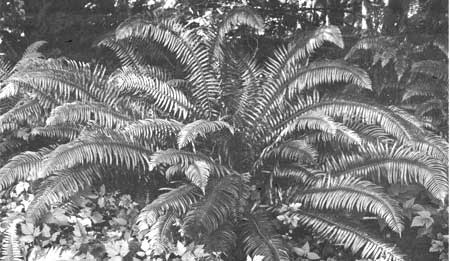 WESTERN SWORDFERN. |
WESTERN SWORDFERN (Polystichum munitum). This is the western counterpart of the common Christmasfern. It is a large, conspicuous, evergreen fern—the most prominent fern in these forests. The individual leaflets are lance-shaped, have fine-toothed edges, and are attached to the stem of the frond by means of a short stalk.
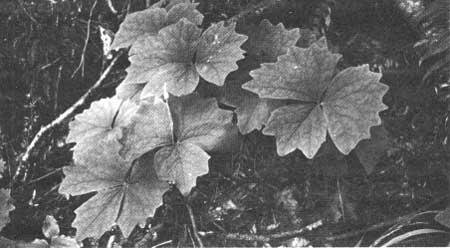 DEERFOOT VANILLALEAF. |
DEERFOOT VANILLALEAF (Achlys triphylla). This is probably the most common herbaceous, flowering plant in these forests from sea level to about 4,000 feet in elevation. It is a foot or more in height and commonly forms extensive patches. It can be identified easily by the three broad, fan-shaped leaves at the top of the slender, wiry stem. If the central leaf is bent back, the other two represent a spreading, green-winged butterfly. The small flowers form a slender, white, upright spike above the leaves. The foliage contains a compound which has the fragrance of vanilla. This is given off when the leaves wilt and accounts for another popular name—sweet-after-death.
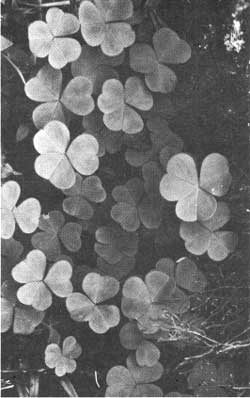 OREGON OXALIS. |
OREGON OXALIS (Oxalis oregana). This small, delicate, white-flowered plant, has leaves that resemble a three-leaf clover. It grows among the mosses in the moist, shady forest and is especially noticeable in the plant carpet on the floor of the rain forest. The plant contains oxalic acid, which gives the leaves a pleasant sour taste. Another common name is wood sorrel.
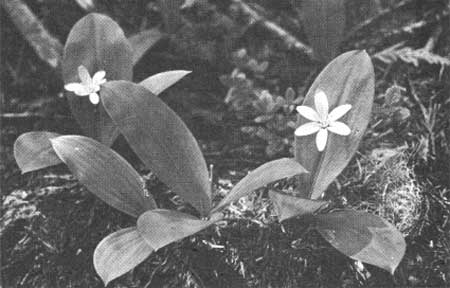 QUEENCUP BEADLILY. |
QUEENCUP BEADLILY (Glintonia uniflora). The hiker will find this attractive plant in flower at middle elevations, mostly in the Canadian zone. Each plant has two or three prominent, narrowly oblong, lilylike leaves growing from the base of the plant and one clear-white, lilylike flower. The fruit is a single turquoise berry.
OREGON WINTERGREEN (Pyrola rotundifolio). This handsome pyrola is found up to about 3,000 feet elevation. Several leathery, roundish leaves, which have stems as long as the leaves, arise from the base of the plant and spread out to form a rosette. They are glossy green on top. From the center of this rosette rises a reddish flower stalk, 8 to 16 inches tall, that bears pink to reddish, waxy flowers about a quarter of an inch in diameter.
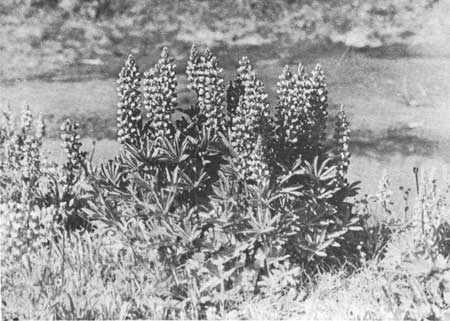 SUBALPINE LUPINE. |
SUBALPINE LUPINE (Lupinus subalpinus). Early in July the mountain meadows become ornamented with large patches of this blue-flowered plant. Its flowers are the shape of pea blossoms. Lupine can be identified by the leaf, which consists of many leaflets radiating from a central point like the spokes of a wheel. This lupine is a leafy plant 8 to 24 inches high.
LYALL LUPINE (Lupinus lyallii). This small lupine grows in dry, rocky soil at higher elevations, mostly above timberline in the Arctic-Alpine zone. Its small, but typically lupine, leaves are hairy and spread out to form a rosette. The blue flowers, in many short, compact spikes, usually are spread in rosette manner.
SCARLET PAINTBRUSH (Castilleja miniata). The brilliant color of this plant is not in its flowers, which are hidden, but in the leafy bracts that surround them. One can imagine that the "flowers" are brushes dipped in scarlet paint and then turned upward.
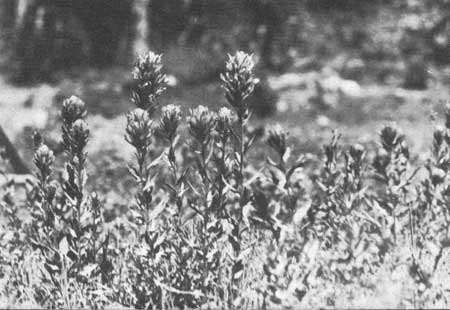 MAGENTA PAINTBRUSH. |
MAGENTA PAINTBRUSH (Castilleja oreopola) is similar to the scarlet paint brush, except in color.
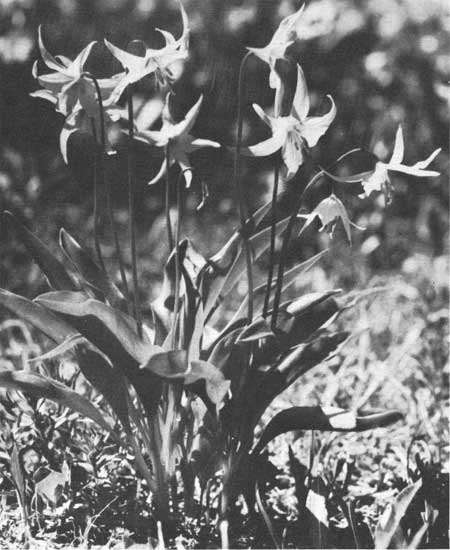 AVALANCHE LILY. |
AVALANCHE LILY (Erythronium montanum) is a white lily, with a yellow center, abundant in early summer on mountain meadows and in woods near timberline.
GLACIER LILY (Erythronium grandiflorum). This plant is similar, except that the flowers are yellow and slightly smaller. It blooms earlier than its white counterpart and one must look for it where the snow is melting. Both the avalanche and glacier lilies have two basal leaves.
OWLCLOVER (Orthocarpus imbricatus) is a relative of the paintbrushes; it incorrectly identified as one of them. The "flower" is magenta-colored, but it differs from that of the paintbrush in being compact and nearly ball-like. Each plant has only one flower stalk, while paintbrush usually has more than one. Paintbrush and owl clover bloom in the mountain meadows in midsummer.
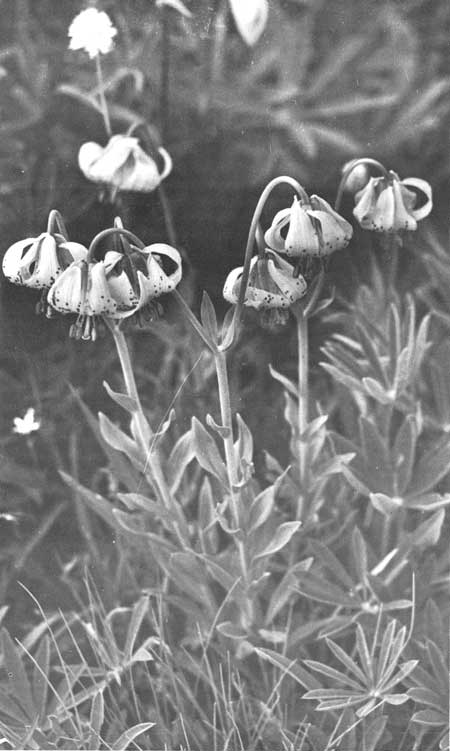 TIGER LILY. |
TIGER LILY (Lilium columbianum) is a tall, leafy plant of the rich meadows that bears from two to many large, orange, brown-spotted flowers. On the lowland meadows the flowers appear in May, but in the meadows of the Hudsonian zone, they do not bloom until July.
MOUNTAIN BUCKWHEAT (Polygonum bistortoides). Although this flower is not especially attractive, its abundance in mountain meadows gives it importance among the common plants of the park. It grows thickly among grasses and sedges, is 10 to 20 inches tall, and in July and August bears a compact, oblong spike of white flowers at the top of the slender stem.
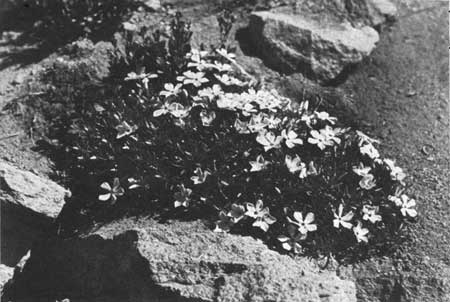 SPREADING PHLOX. |
SPREADING PHLOX (Phlox diffusa) is a prickly, mosslike plant that forms cushions or mats on dry, gravelly slopes above timberline. In early summer, it bears numerous, small, white-to-lavender flowers close to the foliage. Entire hillsides may be covered with a patchwork of this hardy alpine plant.
BLUEBELL (Campanula rotundifolia) grows from sea level to the dry, rocky slopes above timberline. At the higher elevations it blooms from July to September and can be recognized easily by its pale blue, nodding, bell-like flowers about three-quarters of an inch long.

|

|
|
|
|
Last Modified: Sat, Nov 4 2006 10:00:00 pm PST |


